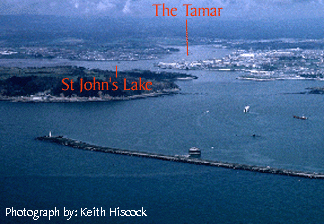
50 21.54N
04 10.08W
| Tamar Estuary | ||
| Lat/long |  |
|
50 21.54N |
04 10.08W |
|
| Location description (1957) | |
| As observed in passage up the Hamoaze-neglecting the built-up areas of Stonehouse and Devonport-the character of the shore becomes increasingly dominated by the large bulk of estuarine deposits, which soon cover all the side of the original rock valley except here and there in the H.W. region. These deposits are also responsible for rapid shallowing of the main channel in the middle region of the estuary, for example, just above Saltash Bridge. Extensive mud flats, which altogether occupy many hundred acres, provide a main feature in this estuary system. These occupy the middle part of the tidal zone of St. John's Lake, the mean level of the flats gradually rising upriver, being mainly above mid-tide at Weir Quay and Bere Ferrers. The mud has a characteristic burrowing (or surface-living) fauna that includes the worrns Nereis diversicolor, Nephthys hombergi and Ampharete grubei; the molluscs Cardium edule, Scrobicularia plana, and Hydrobia ulvae; and the crustaceans Cyathura carinata and Corophium volutator. On the broad flats of St. John's Lake, where the freshwater infiuence is not great, beds of Zostera hornemanniana give cover for additional species, as do also deposits of old mollusc shells. Under cover of tufts of algae, leaf deposits, or other litter, near low water and in the main channel the fauna includes certain crustacean genera which show replacement of species passing into less saline or more protected water. Sphaeroma monodi, S. rugicauda and S. hookeri form one series; that of Gammarus locusta, G. zaddachi salinus, G. z. zaddachi, and G. pulex is even more striking. The variety of species is perhaps at its minimum in the region of Calstock, where typical low-salinity species begin to appear, such as the hydroid Cordylophora lacustris, the amphipod Gammarus chevreuxi and the oligochaete Tubifex tubifex. The more rocky channel just below Saltash is a breeding place of the common jellyfish Aurelia aurita. Mussels flourished for many years on stony ground off Neal Point; and there is an extensive oyster bed in the River Lynher A variety of essentially marine fish enter the estuary and support a small tucknet fishery, described by Hartley (1940). Flounders, bass, grey mullet, and small herring are typical fish in catches; and formerly smelts (Atherina presbyter) were frequent. From March till August salmon are caught in seine nets. The mud-flats support a large population of waders and other shore birds, which reach their maximum in numbers and variety between November and February. The flats in the middle and upper reaches also provide the chief source of food for many breeding pairs of sheldduck (Tadorna tadorna). In the middle reaches of the estuary the mud-filled side branches and bays, between M.H.W. al d H.W. Springs, support a typical saltings vegetation in which Halimione portulacoides predominates. The outer margin of the saltings is at present being eroded in most places and is then separated from the bare mud flat by a salting cliff. Reed beds often take the place of saltings, as the mean salinity drops in the upper reaches, particularly along the Tamar itself. The estuarine grass Sparlina townsendii has recently spread extensively in the upper part of the tidal zone in the middle estuary, growing on bare mud in a few places, but chiefly colonizing established saltings. Between Calstock and Morwellham the very local sedge Schoenoplectus triquetrus grows on the bare mud below H.W. Neaps. |
| Updated information | Description updated in 1999 |
| Species List |
>Alloteuthis subulata Loligo forbesii Ostrea edulis Sepiola atlantica |